 Operation and Maintenance
Operation and Maintenance
 Safety
Safety
 What are the encryption methods commonly used in network security?
What are the encryption methods commonly used in network security?
What are the encryption methods commonly used in network security?

The following are several encryption methods commonly used in network transmission:
(Learning video sharing: Programming video)
Tip: These encryptions involve plain text transmission and need to be encrypted and transmitted over the https protocol.
1. Key hashing
Use MD5 or SHA1 and other hashing algorithms to encrypt the plain text (the encryption here is only for people, not machines, because these algorithms and machines can use corresponding algorithms Calculate it)
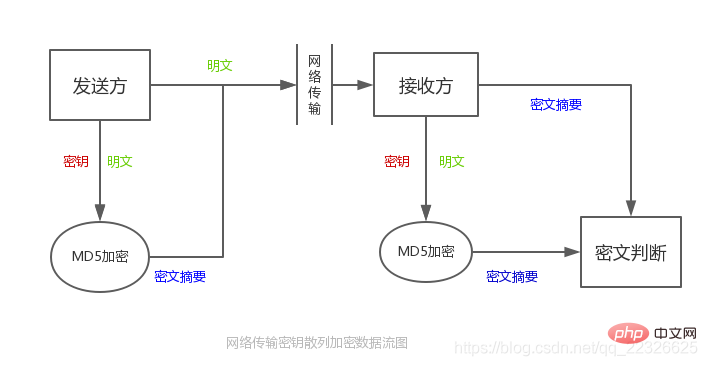
Advantages: Anti-tampering
Applicable scenarios: Ordinary file downloads
Disadvantages: No security, certifiable
2. Symmetric encryption
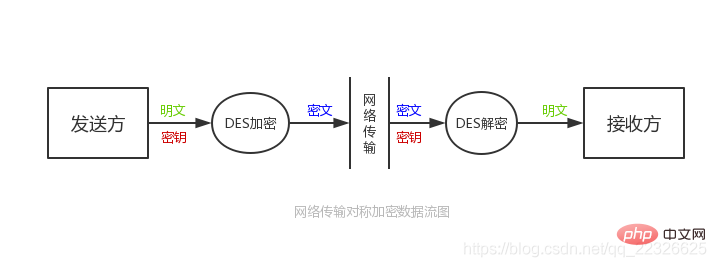
Advantages: safe and authenticable
Applicable scenarios: fixed number of senders and receivers, few key users
Disadvantages: BS network transmission relationship , too many keys are difficult to maintain unless the key is encrypted and transmitted
3. Asymmetric encryption
3.1. The receiver sends the public key (to ensure data integrity)
Premise: The sender receives the receiver's public key during the first communication and saves it locally
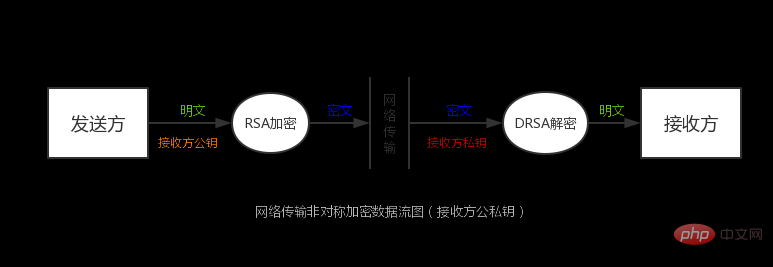
3.2. The sender sends the public key (guaranteeing the sender's authentication)
Premise: The receiver receives the sender’s public key during the first communication and saves it locally
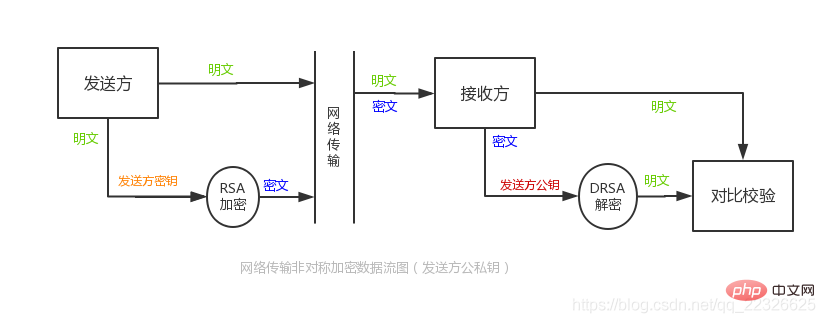
4, digital signature
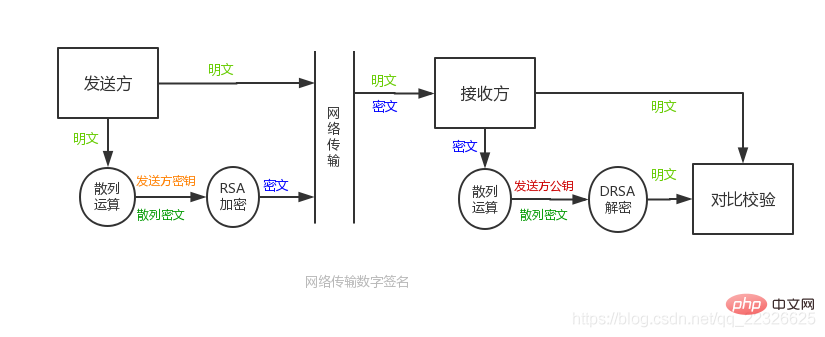
Applicable scenarios: login authentication
Disadvantages: insufficient confidentiality
Shorthand
Symmetric Algorithm
Symmestric Algorithm.Create ()=>
Provider.CreateEncryptor()
Provider.CreateDecryptor()
CryptoStream(Stream stream,ICrytoTransform transform,CryptoStreamMode mode):
CryptoStream(encryptedSteam,encryptor,CryptoStreamMode.Write)/ /Encryption is ready to read empty encryptedSteam is ready to be written
CryptoStream(encryptedSteam,decryptor,CryptoStreamMode.Read)//Decryption is ready to be written into the ciphertext stream encryptedSteam is ready to be read
Asymmetric encryption
Asymmetric encryption (ASymmisticAlgorithm):
Provider provider
provider.ToXmlString(true);//Get the public and private key pair
provider.ToXmlString(false);//Get the public key
provier .FromXmlString(publicKeyXml);
provier.FromXmlString(privateKeyXml);
provider.Encrypt();
provider.Decrypt();
Example:
Symmetric encryption :
string key = "abc";
string sendContent="你好!";
var byteKey = Encoding.UTF8.GetBytes(key);
var byteIV = Encoding.UTF8.GetBytes(key);//加密算法初始化向量
DESCryptoServiceProvider des = new DESCryptoServiceProvider();//使用des加密
byte[] bytesContent = Encoding.UTF8.GetBytes(sendContent);
MemoryStream ms = new MemoryStream();
CryptoStream cs = new CryptoStream(ms, des.CreateEncryptor(byteKey, byteIV), CryptoStreamMode.Write);
cs.Write(bytesContent, 0, bytesContent.Length);
cs.FlushFinalBlock();Related recommendations: Website Security Tutorial
The above is the detailed content of What are the encryption methods commonly used in network security?. For more information, please follow other related articles on the PHP Chinese website!

Hot AI Tools

Undresser.AI Undress
AI-powered app for creating realistic nude photos

AI Clothes Remover
Online AI tool for removing clothes from photos.

Undress AI Tool
Undress images for free

Clothoff.io
AI clothes remover

AI Hentai Generator
Generate AI Hentai for free.

Hot Article

Hot Tools

Notepad++7.3.1
Easy-to-use and free code editor

SublimeText3 Chinese version
Chinese version, very easy to use

Zend Studio 13.0.1
Powerful PHP integrated development environment

Dreamweaver CS6
Visual web development tools

SublimeText3 Mac version
God-level code editing software (SublimeText3)

Hot Topics
 1377
1377
 52
52
 How to set up Win10 firewall whitelist? Win10 plus firewall whitelist
Jul 14, 2023 pm 03:18 PM
How to set up Win10 firewall whitelist? Win10 plus firewall whitelist
Jul 14, 2023 pm 03:18 PM
The built-in firewall function of win10 can block the attacks of some malicious programs for us, but occasionally it may be blocked by the firewall and prevent the program from being installed normally. If we can understand the security of this software and the importance of installation, then we can allow the installation by adding a whitelist to the firewall. 1. Use the win key to open the win10 system menu window, and click on the left side of the menu window to open the "Settings" dialog box. 2. In the Windows Settings dialog box that opens, you can look for the "Update & Security" item and click to open it. 3. After entering the upgrade and security policy page, click the "Windows Security Manager" sub-menu in the left toolbar. 4. Then in the specific content on the right
 Master network security and penetration testing in Go
Nov 30, 2023 am 10:16 AM
Master network security and penetration testing in Go
Nov 30, 2023 am 10:16 AM
With the development of the Internet, network security has become an urgent issue. For technical personnel engaged in network security work, it is undoubtedly necessary to master an efficient, stable, and secure programming language. Among them, Go language has become the first choice of many network security practitioners. Go language, referred to as Golang, is an open source programming language created by Google. The language has outstanding features such as high efficiency, high concurrency, high reliability and high security, so it is widely used in network security and penetration testing.
 Artificial Intelligence in Cybersecurity: Current Issues and Future Directions
Mar 01, 2024 pm 08:19 PM
Artificial Intelligence in Cybersecurity: Current Issues and Future Directions
Mar 01, 2024 pm 08:19 PM
Artificial intelligence (AI) has revolutionized every field, and cybersecurity is no exception. As our reliance on technology continues to increase, so do the threats to our digital infrastructure. Artificial intelligence (AI) has revolutionized the field of cybersecurity, providing advanced capabilities for threat detection, incident response, and risk assessment. However, there are some difficulties with using artificial intelligence in cybersecurity. This article will delve into the current status of artificial intelligence in cybersecurity and explore future directions. The role of artificial intelligence in cybersecurity Governments, businesses and individuals are facing increasingly severe cybersecurity challenges. As cyber threats become more sophisticated, the need for advanced security protection measures continues to increase. Artificial intelligence (AI) relies on its unique method to identify, prevent
 How do C++ functions implement network security in network programming?
Apr 28, 2024 am 09:06 AM
How do C++ functions implement network security in network programming?
Apr 28, 2024 am 09:06 AM
C++ functions can achieve network security in network programming. Methods include: 1. Using encryption algorithms (openssl) to encrypt communication; 2. Using digital signatures (cryptopp) to verify data integrity and sender identity; 3. Defending against cross-site scripting attacks ( htmlcxx) to filter and sanitize user input.
 Ten methods in AI risk discovery
Apr 26, 2024 pm 05:25 PM
Ten methods in AI risk discovery
Apr 26, 2024 pm 05:25 PM
Beyond chatbots or personalized recommendations, AI’s powerful ability to predict and eliminate risks is gaining momentum in organizations. As massive amounts of data proliferate and regulations tighten, traditional risk assessment tools are struggling under the pressure. Artificial intelligence technology can quickly analyze and supervise the collection of large amounts of data, allowing risk assessment tools to be improved under compression. By using technologies such as machine learning and deep learning, AI can identify and predict potential risks and provide timely recommendations. Against this backdrop, leveraging AI’s risk management capabilities can ensure compliance with changing regulations and proactively respond to unforeseen threats. Leveraging AI to tackle the complexities of risk management may seem alarming, but for those passionate about staying on top in the digital race
 Roborock sweeping robot passed Rheinland dual certification, leading the industry in corner cleaning and sterilization
Mar 19, 2024 am 10:30 AM
Roborock sweeping robot passed Rheinland dual certification, leading the industry in corner cleaning and sterilization
Mar 19, 2024 am 10:30 AM
Recently, TUV Rheinland Greater China ("TUV Rheinland"), an internationally renowned third-party testing, inspection and certification agency, issued important network security and privacy protection certifications to three sweeping robots P10Pro, P10S and P10SPro owned by Roborock Technology. certificate, as well as the "Efficient Corner Cleaning" China-mark certification. At the same time, the agency also issued self-cleaning and sterilization performance test reports for sweeping robots and floor washing machines A20 and A20Pro, providing an authoritative purchasing reference for consumers in the market. As network security is increasingly valued, TUV Rheinland has implemented strict network security and privacy protection for Roborock sweeping robots in accordance with ETSIEN303645 standards.
 Artificial Intelligence's Digital Shield: Enhancing Infrastructure Cybersecurity Strategies
Sep 14, 2023 pm 02:45 PM
Artificial Intelligence's Digital Shield: Enhancing Infrastructure Cybersecurity Strategies
Sep 14, 2023 pm 02:45 PM
In an era of technological innovation, artificial intelligence (AI) stands out as a transformative force. From personalized recommendations to self-driving cars, the potential of artificial intelligence seems limitless. As businesses increasingly rely on artificial intelligence to enhance operations, they must also address a critical issue: cybersecurity. This article explores the intersection of artificial intelligence and cybersecurity and provides insights into protecting AI infrastructure in a rapidly evolving digital environment. Artificial intelligence has brought significant advancements to various industries, but it has also brought new cybersecurity challenges. Machine learning algorithms, while powerful, are also vulnerable to attacks. Cybercriminals can manipulate data or inject malicious code, potentially compromising the integrity and confidentiality of AI systems. 1. Lay a solid foundation. Network security starts with a solid foundation.
 Network security reinforcement techniques for building web servers under CentOS 7
Aug 05, 2023 pm 01:12 PM
Network security reinforcement techniques for building web servers under CentOS 7
Aug 05, 2023 pm 01:12 PM
Network security reinforcement techniques for building web servers under CentOS7 The web server is an important part of the modern Internet, so it is very important to protect the security of the web server. By hardening network security, you can reduce risks and avoid potential attacks. This article will introduce network security reinforcement techniques commonly used when building web servers on CentOS7, and provide corresponding code examples. Update your system and software First, make sure your system and software are up to date. You can use the following command to update



